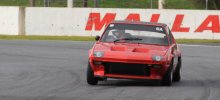Endurance racing is much about preparation of the car, team, support for all involved, organization and dealing with some of the most remarkable things that could and does happen.
Testing is mandatory to sort out the car and all involved. If that is not done to a high level of preparedness, well before the event remarkable surprises happen.
That said, endurance racing can be one of the most rewarding challenges any moto fan can get involved with.
Bernice
Endurance racing is all about preparation. Of course with a new car, you don't know what will break. That first event will be all about sorting out the car.
I couldn't agree more with you both...
Unfortunately my friend Eddie just told me the other day he won't be a starter, financial issues with work hours and covid etc for him, but that's OK as there's still 6 months to go before raceday. I'm sure he'll come along and give a hand this time around, maybe the next run he will be a starter.
So I figure if I only have a team of four the schedule is maybe something like this. An 8 hour race is actually a lot easier to manage, I sort of wasn't looking forward to the long night / managing fatigue (for me personally too being driver/bulder/team owner) over a 24 hour non stop race.
Raceday is 14/15/16th October 2021
Thurday afternoon practice 4 hours, limit of 4 vehicles on track at once, short track only.
Scruitineering is Thursday morning, that's the big one for me.
Friday / Saturday. Race day 8 hours each day, Friday short track, Saturday long track.
My thoughts are 100 minute stints, and allow 5 minutes for refuel / driver change / vehicle check (hopefully quicker but I'm being realistic)
100 minutes should be enough time to get well settled into the car, but not too much time, so that fatigue / dehydration will still be manageable.
8 hours is 480 minutes.
Stint one, Driver one : start - 100 mins.
1st refuel and 1st driver change at 100 minutes, back out at 105 minutes.
Stint two, Driver two : 105 minutes - 205 minutes.
2nd refuel and 2nd driver change at 205 minutes, back out at 210 minutes
Stint three, Driver three : 210 minutes - 310 minutes.
3rd refuel and 3rd driver change at 310 minutes, back out at 315 minutes.
Stint 4, Driver 4: 315 minutes - 415 minutes
4th refuel and Final driver change at 415 minutes, back out at 420 minutes
Stint 5, Driver TBD: 420 minutes - 480 minutes
fastest driver of the day (on an average lets say, not just a blinder) gets to go out and do a second stint for the day, and it's the last 60 minutes to the chequered flag, and hopefully with the car running well, gets to push hard to the end.
I will definitely get in a test day or two before hand., not a chance I'm going to turn up untested for an 8 hour run,. Engine will need to be run in, possibly two sets of pads and two sets of rotors bedded in, and at least two set of tyres need to be scrubbed...
My mate Mark is a definite starter - unless there happens to be a covid lockdown right when he's due to fly in or something not in our control like that. He flies in from Sydney on Thursday morning at 8.30am, then he's picking up his rental motor home RV thing at the airport and driving out to the track so should be there by 12 lunchtime. He should then have enough time to get a couple of decent 30 minute sessions in and learn the track and post a time / present his gear / license etc. I'm sure his Thursday evening will be spent fitting go-pro's and making sure that is all good to go for the next day. His RV motorhome is going to be base of operations, and a place to kip
Martin , Mark and myself will be driving the long track for the first time ever on Saturday, none of the test and tune days are long track, but that's cool and will be interesting data
Con isn't a definite yet. I think maybe he wants to see the cage in the car before he commits, but say's he likes the way the builds heading. He's entering one of his Mini's in Aprils event, so I'll go along and spectate / check out the "lay of the land" , hopefully with Martin.
So there are bragging rights and an extra hour of drive to the chequred flag to drive for. A drivers entry fee and share of the tyres/fuel etc could be ... remember could be... for up to 320 minutes of drive time over the weekend. I think that's good incentive to keep it smooth/fast and always pointing in the right direction, like I said not just FTOD, but a mean lap time / average of 10/20 laps / no penalties.
SteveC


